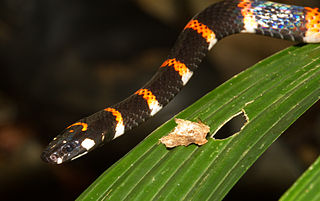
Scincella is a genus of lizards in the skink family, Scincidae, commonly referred to as ground skinks. The exact number of species in the genus is unclear, as taxonomic reclassification is ongoing, and sources vary widely. Scincella species primarily range throughout the temperate regions of the world and are typically small, fossorial lizards, which consume a wide variety of arthropods. They are a generalized insectivore with well developed chemosensory abilities.

Scincella reevesii is a species of skink, a lizard in the family Scincidae. The species is endemic to Asia.

Kaestlea travancorica, also known as the Travancore ground skink or Barbour's ground skink, is a species of skink endemic to southern Western Ghats.

Sphenomorphus dussumieri, commonly known as Dussumier's forest skink and Dussumier's litter skink, is a species of skink, a lizard in the family Scincidae. The species is endemic to southern India.

Scincella lateralis, formerly Lygosoma laterale is a small species of skink found throughout much of the eastern half of the United States, and into northern Mexico. The ground skink differs from the majority of North American lizard species in that it is generally considered a forest dweller. Common names for this species include the little brown skink and the ground skink. However, the common name, ground skink, may refer to any species in the genus Scincella.

The banded supple skink, also known commonly as Harold's writhing skink and Harold Young's supple skink, is a species of lizard in the family Scincidae. The species is endemic to Southeast Asia.

The fire skink, also known commonly as Fernand's skink, the Togo fire skink, and the true fire skink, is a fairly large skink, a species of lizard in the family Scincidae. The species is known for its bright and vivid coloration. Native to tropical forests in West and Central Africa, the fire skink lives fifteen to twenty years. This species is a diurnal lizard that burrows and hides. It is relatively shy and reclusive, but may become tame in captivity.

Scincella gemmingeri, commonly known as the forest ground skink, Cope's forest ground skink, and la escíncela de bosque de Cope in Mexican Spanish, is a species of lizard in the family Scincidae. The species is endemic to Mexico.

Scincella vandenburghi, also known commonly as the Korean skink, the Tsushima ground skink, and the Tsushima smooth skink, is a species of skink, a lizard in the family Scincidae. The species is endemic to East Asia

Lipinia pulchella, known commonly as the yellow-striped slender tree skink or beautiful lipinia, is a species of skink, a lizard in the family Scincidae. The species is endemic to the Philippines.

Pliocercus euryzonus, commonly known as Cope's false coral snake, is a species of snake in the subfamily Dipsadinae of the family Colubridae. The species is indigenous to southeastern Central America and northwestern South America. There are two recognized subspecies.
Nannoscincus slevini, also known commonly as Slevin's elf skink and Slevin's dwarf skink, is an endangered species of lizard in the family Scincidae. The species is endemic to New Caledonia.
Mochlus hinkeli, also known commonly as Hinkel's red-flanked skink and Hinkel's red-sided skink, is a species of lizard in the family Scincidae. The species is native to eastern Central Africa and East Africa. There are two recognized subspecies.
Ctenotus stuarti, also known commonly as the Point Stuart ctenotus or Stuart's ctenotus, is a species of skink, a lizard in the family Scincidae. The species is endemic to Australia.

Kaestlea beddomii, also known as Beddome's ground skink, is a species of lizard in the family Scincidae. The species is endemic to the Western Ghats of India.
Scincella boettgeri, Boettger's ground skink, is a species of lizard in the family Scincidae. The species is native to the Ryukyu Islands of Japan.
Scincella doriae, also known commonly as Doria's ground skink and Doria's smooth skink, is a species of lizard in the family Scincidae. The species is native to Southeast Asia.
Scincella forbesorum, also known commonly as Forbes' forest ground skink and la escíncela de bosque de Forbes in Mexican Spanish, is a species of lizard in the family Scincidae. The species is endemic to Mexico.

Plestiodon copei, also known commonly as Cope's skink, is a species of lizard in the family Scincidae. The species is endemic to Mexico.













